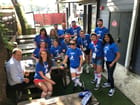As economic uncertainty unfurls over the globe, news of a company that’s growing feels hopeful.
MongoDB is one such company. In the past six months, the Austin database company has seen laudable growth — including 62 new hires and 58 promotions, according to the company. Cleat Broome, a senior manager of customer success, said that the company’s success is due in part to quick reflexes in shifting to remote-friendly practices that allowed employees to continue excelling in their roles and maintain company culture.
“We had to change a ton of our processes in a very short amount of time,” Broome said. “That’s tough for anyone in any role. But we’ve had the benefit of actually getting more resources than ever to do our jobs. There are more strategic initiatives now than before COVID-19.”
Broome added that teams across the organization are rethinking how they approach their day-to-day work, from tracking and gauging customer health to how they onboard new employees.
“The real challenge we’ve been able to overcome is balancing all of these changes while still setting our team up for success,” Broome said.
So, how are they doing it? Built In Austin talked with members of MongoDB to find out.

What are some of the adjustments you’ve had to make since going remote? How do you keep your team supported, connected and motivated?
Corporate Senior Director James Cutrer: I’m honest with my younger sellers about the importance of separating work and life. For the most part, they’re in their homes and they can’t really leave to go to their favorite spots or to see their friends. Taking a step away has been a big focus of mine and my leadership team to make sure the team doesn’t burn out. I really encourage them to build breaks into their day, listen to how different people are handling the situation and take time off.
Taking a step away has been a big focus of mine and my leadership team to make sure the team doesn’t burn out.”
Senior Manager of Customer Success Cleat Broome: We’ve revamped our team meetings to provide more opportunities to collaborate. Our goal was to replicate the effortless collaboration and communication that we had when we sat a few feet away from our co-workers.
To continue our rapid evolution while keeping teams motivated, I’m doing a lot of anonymous surveying by asking team members how they like the new processes and what we could be doing better.
Regional Sales Development Manager Stephen Drake: Culture is one of the main aspects of any organization that moves everyone in the same direction, but it is difficult to preserve when only one person can speak at a time during a 50-person social meeting. Now, we end Fridays with a social Zoom meeting to break into smaller groups to reconnect with folks that we otherwise would have limited access to. We’ve also created a Slack channel where people can post their successes in their role or a leader or peer can give a shout out to someone who went out of their way to assist someone else.
Weekly Meeting Agenda
- Monday: Team huddle to break down blockers and share priorities for the week.
- Tuesday: Lightning talks where every week someone gives a presentation on a skill.
- Thursday: Roundtable to discuss wins and challenges of the week.
- Friday: Unwind with co-workers in a virtual happy hour!
What are some new projects and initiatives the CSM and sales teams have rolled out to better support customers during this time?
Broome: I’ll call out two recent initiatives that I’m especially excited about. We have a customer accelerator initiative, where CSMs partner directly with our consulting engineers to help increase adoption and mitigate risk in their accounts. This program allows CSMs to solve technical problems faster and build relationships with some of MongoDB’s most experienced engineers.
We also rolled out an executive sponsorship program, where CSMs pair MongoDB executives with executives from some of our largest customers to build relationships and trust with our product. This has allowed CSMs to collaborate and plan directly with our CEO, COO and various other executives on their accounts.
Drake: To overcome any lack of in-person interaction, we decided to shake things up and start using video messaging for customer outreach. Not only is it a new skill to learn, but it creates a very different experience for our customers who have been missing human interaction. The feedback that our reps have received has been tremendous. Our customers have been very enthusiastic in their responses, and we think this is a new skill every seller should learn.

We know you’ve onboarded a few new hires during this time. How are you supporting these new employees?
Cutrer: We’ve been growing pretty fast — the team has more than doubled in the last six months. In the past, we had a five-week onboarding program where new hires would go to New York. Obviously, we can’t do that anymore. So instead, we built out a separate virtual boot camp.
To avoid Zoom fatigue, we’ve added more things for new hires to learn by doing. They’ll listen to more calls, fill out what they heard and then we’ll review those calls with them. They’ll get accounts assigned and think about how they’d attack that account if it were assigned to them. So instead of in-classroom learning, we’ve taken an approach of having new hires learn through experience.
Drake: The biggest thing that you miss in virtual onboarding is the ability to turn around and tap someone on the shoulder and ask for help. So we’ve tried to simulate an environment where everyone around you is present and there to help. We have a pool of people that we assign to help mentor our new hires, or be their buddies. Through the onboarding process, our managers hold office hours every day to ensure there’s time for the new hires to ask questions and get new insights.
What advice do you have for other leaders looking to build out more supportive processes for their teams?
Cutrer: Take breaks to stay checked into what a good workflow looks like. That’s a big priority for me because the biggest feedback I get is that there’s so much information, it’s easy to get overwhelmed. By slowing down and understanding when my team is overwhelmed allows me to help them better manage their time and ultimately, their week, month and quarter.
Broome: Empower your team. Whether it’s involving them in process building or surveying them often, lean on their talent. There’s a lot of knowledge that lives in your team — ask yourself how much you are leveraging it. Are you taking advantage of the expertise that you already have to help scale and build a team in these times?
There’s a lot of knowledge that lives in your team — ask yourself how much you are leveraging it.”
Drake: In such a data-driven, fast-paced world, having a high level of emotional intelligence is more important than it ever has been. Be extremely intentional about how you are socializing with your team. How are you developing them? How are you being vulnerable with them and asking for them to be vulnerable in return? I think all that’s my No. 1 piece of advice because it’s made this transition as seamless as it could have been.








